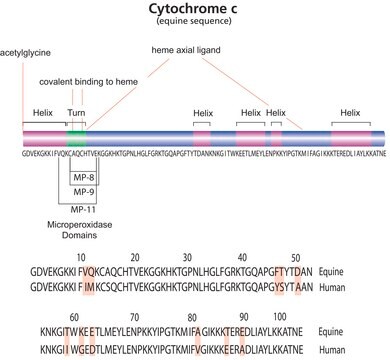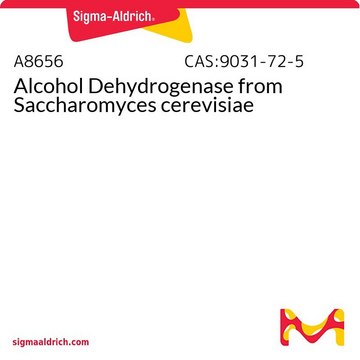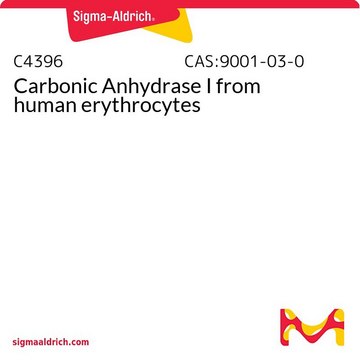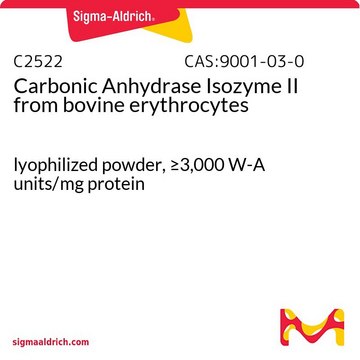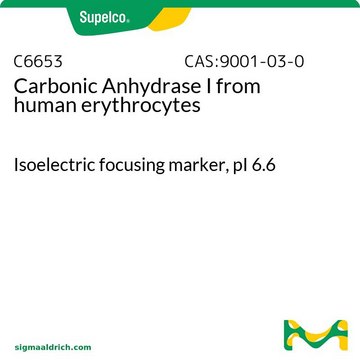C7025
Carbonic Anhydrase from bovine erythrocytes
BioReagent, suitable for GFC marker
Synonym(s):
Carbonate Dehydratase, Carbonate Hydrolyase
Sign Into View Organizational & Contract Pricing
All Photos(1)
About This Item
Recommended Products
product line
BioReagent
Quality Level
form
powder
mol wt
~29,000
packaging
vial of 15 mg
suitability
suitable for GFC marker
storage temp.
−20°C
Looking for similar products? Visit Product Comparison Guide
Application
Carbonic Anhydrase from bovine erythrocytes is a bioreagent used in gel filtration chromatography, protein chromatography and plasma and blood proteins. Carbonic anhydrase has been used to study compounds widely known to have anticancer properties against human cancers and that act as diuretic, antibacterial, antifungal, antitubercular and leishmanicidal agents.
Gel filtration molecular weight marker
Signal Word
Danger
Hazard Statements
Precautionary Statements
Hazard Classifications
Resp. Sens. 1
Storage Class Code
11 - Combustible Solids
WGK
WGK 3
Flash Point(F)
Not applicable
Flash Point(C)
Not applicable
Personal Protective Equipment
dust mask type N95 (US), Eyeshields, Gloves
Certificates of Analysis (COA)
Search for Certificates of Analysis (COA) by entering the products Lot/Batch Number. Lot and Batch Numbers can be found on a product’s label following the words ‘Lot’ or ‘Batch’.
Already Own This Product?
Find documentation for the products that you have recently purchased in the Document Library.
Customers Also Viewed
Wisath Sae-Lee et al.
Cell reports, 40(3), 111103-111103 (2022-07-21)
Red blood cells (RBCs) (erythrocytes) are the simplest primary human cells, lacking nuclei and major organelles and instead employing about a thousand proteins to dynamically control cellular function and morphology in response to physiological cues. In this study, we define
Do Hyeon Kim et al.
Journal of microbiology and biotechnology, 30(12), 1905-1911 (2020-10-14)
Homoserine dehydrogenase (HSD) catalyzes the reversible conversion of L-aspartate-4- semialdehyde to L-homoserine in the aspartate pathway for the biosynthesis of lysine, methionine, threonine, and isoleucine. HSD has attracted great attention for medical and industrial purposes due to its recognized application
Leo Syrjänen et al.
Journal of medicinal chemistry, 56(18), 7372-7381 (2013-08-28)
Leishmaniasis is an infection provoked by protozoans belonging to the genus Leishmania. Among the many species and subsepecies of such protozoa, Leishmania donovani chagasi causes visceral leishmaniasis. A β-carbonic anhydrase (CA, EC 4.2.1.1) was cloned and characterized from this organism
Yanhong Pang et al.
The Journal of biological chemistry, 288(26), 19081-19089 (2013-05-16)
Domain V of the 23S/25S/28S rRNA of the large ribosomal subunit constitutes the active center for the protein folding activity of the ribosome (PFAR). Using in vitro transcribed domain V rRNAs from Escherichia coli and Saccharomyces cerevisiae as the folding
F E Lock et al.
Oncogene, 32(44), 5210-5219 (2012-12-05)
The sub-population of tumor cells termed 'cancer stem cells' (CSCs) possess the capability to generate tumors, undergo epithelial-mesenchymal transition (EMT) and are implicated in metastasis, making treatments to specifically target CSCs an attractive therapeutic strategy. Tumor hypoxia plays a key
Our team of scientists has experience in all areas of research including Life Science, Material Science, Chemical Synthesis, Chromatography, Analytical and many others.
Contact Technical Service


